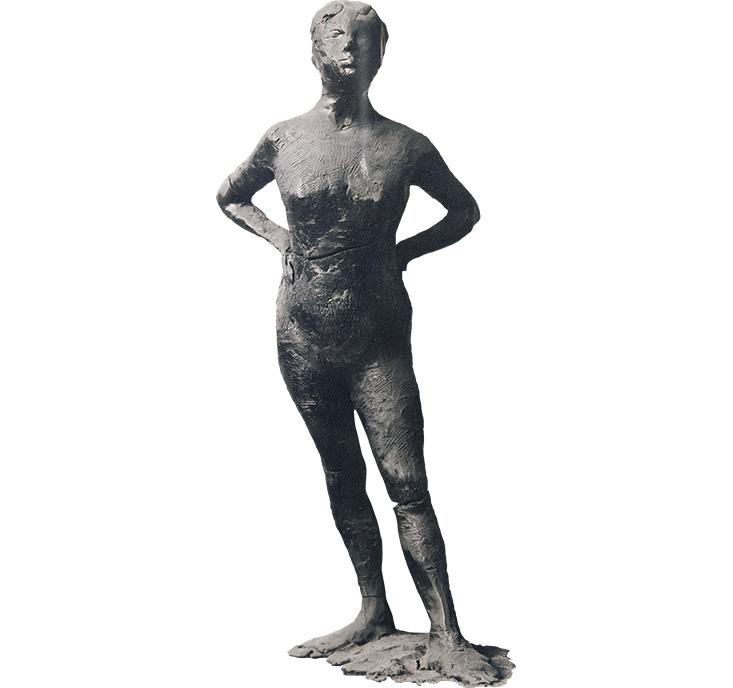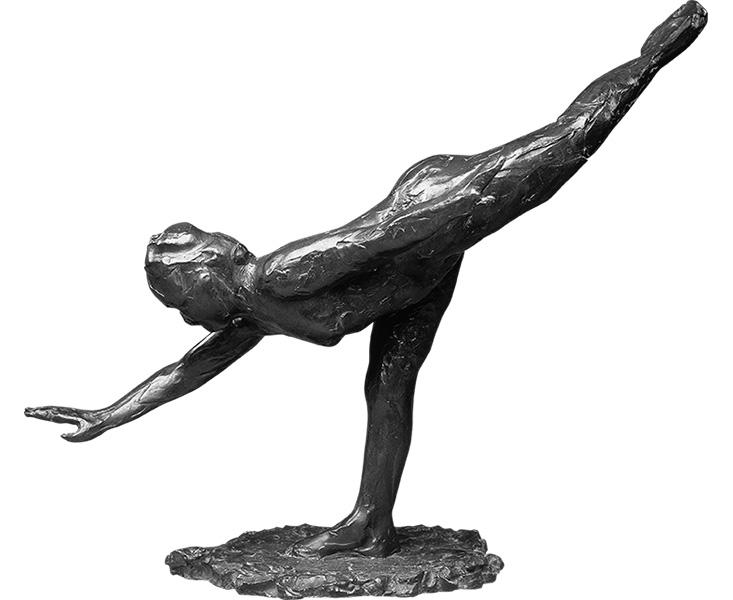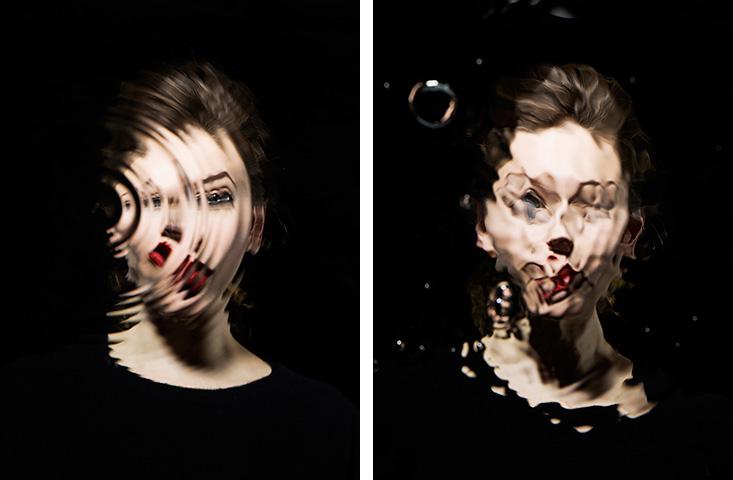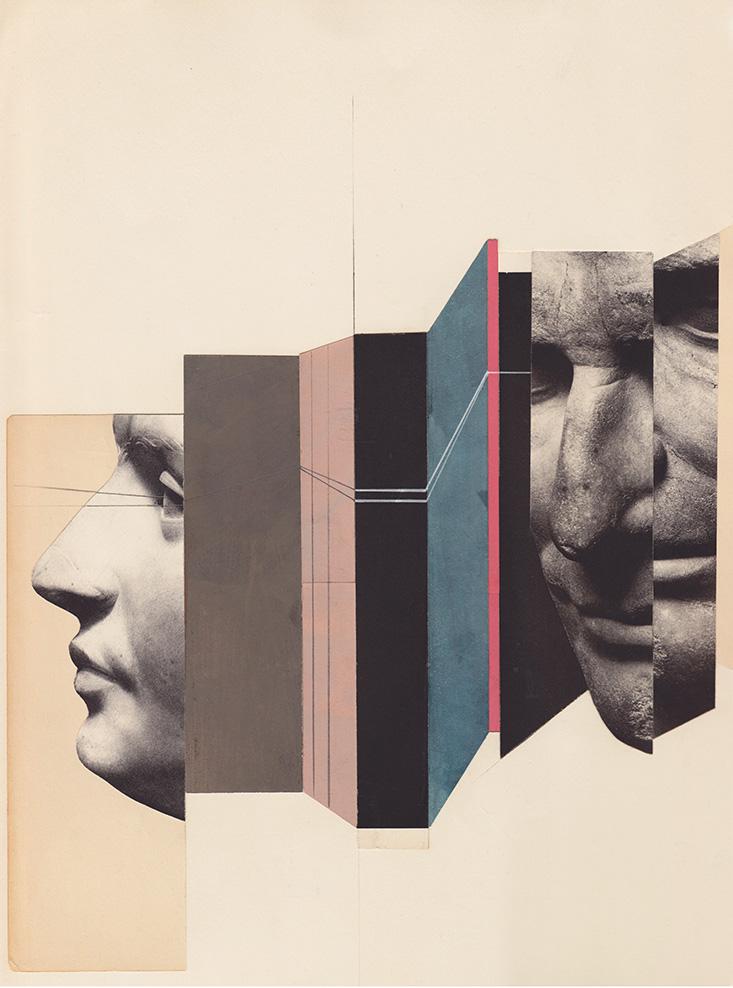On a recent Saturday morning, my wife, Susan, and I slipped into the city to visit the Metropolitan Museum of Art, a place we hadn’t gone together since before our sons were born. The crowds hadn’t yet descended and for an hour or so we wandered around and absorbed the cavernous hush of art. We separated for a bit, together but apart; while Susan roamed among the Manets and Van Goghs I slipped into a small side gallery, not much larger than a subway car, that held a series of glass cases with small bronze sculptures by Degas. There were a few busts and several horses in stride and the figure of a woman stretching, a small bronze rising to her feet and curling her left arm upward as if waking from a long nap.
At the end of the gallery, in one long case, were two dozen ballerinas in various states of motion or repose. One dancer was examining the sole of her right foot; another was putting on her stocking; a third stood with her right leg forward and her hands behind her head. Arabesque decant—tilted forward on one foot, arms outstretched, like a child imitating an airplane. Arabesque devant—upright on left leg, right leg pointed forward, left arm overhead. Their motion was frozen yet still fluid; I felt as though I had wandered into a rehearsal and the dancers had paused just long enough for me to appreciate the mechanics of their grace. At one point a group of young men wandered through whom I also took to be dancers. Their instructor said, “Quick, which one are you right now?” and they each picked out a bronze to emulate— the man nearest me with his right leg forward and his hands on his hips, elbows winged backward. “I like that you picked that one, John,” the instructor said.

Time flies when you’re having fun. It can slow in moments of duress, during a car crash or fall from a roof, or distort under the influence of intoxicants, moving faster or slower depending on the agent. There are myriad lesser-known ways to bend time too, and scientists are discovering more all the time. For instance, consider the two sculptures by Degas above and below this paragraph.

They belong to the series I was viewing, which demonstrates the dance positions across the range of exertion; the ballerina on the left is at rest and the ballerina on the right is executing the third movement of the great arabesque. The sculptures (and the images of them) aren’t moving, but the ballerinas depicted seem to be—and that, it turns out, is enough to alter your perception of time.
In a study published in 2011, Sylvie Droit-Volet, a neuropsychologist at Université Blaise Pascal, in Clermont-Ferrand, France, and three co-authors showed images of the two ballerinas to a group of volunteers. The experiment was what’s known as a bisection task. First, on a computer screen, each subject was shown a neutral image lasting either 0.4 seconds or 1.6 seconds; through repeated showings, the subjects were trained to recognize those two intervals of time, to get a feel for what each is like. Then one or the other ballerina image appeared onscreen for some duration in between those two intervals; after each viewing, the subject pressed a key to indicate whether the duration of the ballerina felt more like the short interval or the long one. The results were consistent: the ballerina en arabesque, the more dynamic of the two figures, seemed to last longer on screen than it actually did.
That makes a certain sense. Related studies have revealed a link between time perception and motion. A circle or triangle that moves quickly across your computer monitor will seem to last longer on screen than a stationary object does; the faster the shapes move, the bigger the distortion. But the Degas sculptures aren’t moving—they merely suggest movement. Typically, duration distortions arise because of the way you perceive certain physical properties of the stimulus. If you observe a light that blinks every tenth of a second and simultaneously hear a series of beeps at a slightly slower rate—every fifth of a second,1 say—the light will seem to you to blink more slowly than it does, in time with the beep. That’s a function of the way our neurons are wired; many temporal illusions are actually audiovisual illusions. But with Degas there’s no time-altering property—no motion—to be perceived. That property is entirely manufactured by, and in, the viewer—reactivated in your memory, perhaps even reenacted. That simply viewing a Degas can bend time in this way suggests a great deal about how and why our internal clocks work as they do.
One of the richest veins in temporal-perception research is on the effect of emotion on cognition, and Droit-Volet has conducted a number of compelling studies that explore the relationship. In a recent series of experiments, her subjects viewed a series of images of faces, each of which was neutral or expressed a basic emotion, such as happiness or anger. Each image lasted onscreen for anywhere from 0.4 seconds to 1.6 seconds, and the viewer was asked to say whether the image lasted for a “short” or a “long” time—that is, closer to one of the two standard durations they’d been trained beforehand to recognize. Consistently, viewers reported that happy faces seemed to last longer than neutral ones, and both angry and fearful faces seemed to last longer still. (The angry faces lasted even longer to 3-year-old children, Droit-Volet found.)

The key ingredient seems to be a physiological response called arousal, which isn’t what you might think. In experimental psychology, “arousal” refers to the degree to which the body is preparing itself to act in some manner. It’s measured through heart rate and the skin’s electrical conductivity; sometimes subjects are asked to rate their own arousal in comparison to images of faces or puppet figures. Arousal can be thought of as the physiological expression of one’s emotions or, perhaps, as a precursor of physical action; in practice there may be little difference. By standard measures, anger is the most arousing emotion, for viewer and angry person alike, followed by fear, then happiness, then sadness. Arousal is thought to accelerate our internal metronome, causing more ticks than usual to accumulate in a given interval, thereby making emotionally laden images seem to last longer than others of equal duration. In Droit-Volet’s study, sad faces were deemed to last longer than neutral faces but not to the same degree as happy ones did.
Physiologists and psychologists think of arousal as a primed physical state—not moving but poised to move. When we see movement, even implied movement in a static image, the thinking goes, we enact that movement internally. In a sense, arousal is a measure of your ability to put yourself in another person’s shoes. Studies find that if you watch an action—someone’s hand picking up a ball, say—the muscles in your hand become primed for action. The muscles don’t move, but their electrical conductivity rises as if they were prepared to do so, and your heart rate increases slightly too. Physiologically speaking, you’re aroused. The same will occur if you merely observe a hand resting next to an object—presumably primed to pick it up—or even just a photograph of a hand holding the object.
A wealth of research suggests that this sort of thing goes on all the time in our daily lives. We mimic each other’s faces and gestures, often unknowingly; various studies have found that subjects will imitate a facial expression even when, through laboratory trickery, they aren’t aware that they’re seeing a face. Moreover, this sort of mimicry induces physiological arousal and seems to open a path that helps us perceive emotions in others. Studies find that if you make a face as though you’re expecting a shock, the actual shock, when it comes, will feel more painful. Exaggerating your facial expression while viewing pleasant or unpleasant film clips amplifies your heart rate and skin conductivity, the typical measures of physiological arousal. Studies using fMRI have found that the same areas of the brain are activated whether the subject experiences a particular emotion, such as anger, or observes a facial expression of it. Arousal signals a bridge to the interior lives of others. If you see a friend feeling angry, you don’t merely infer how she feels: You literally feel what she feels. Her state of mind, and state of motion, become yours too.
And so does her sense of time. In the last few years, Droit-Volet and others have demonstrated that when we embody another person’s action or emotion, we embody the temporal distortions that come with it. In one experiment, Droit-Volet had her subjects view a series of faces—some elderly, some young—briefly on a computer screen, in no particular order or pattern. She found that the viewers consistently underestimated the duration of the elderly faces but not the young ones. In other words, when the viewers saw an elderly face, their internal clocks slowed down as if to “embody the slow movements of elderly people,” Droit-Volet writes. A slower clock ticks less often in a given interval of time; fewer ticks accumulate, so the interval is judged to be briefer than it actually is. Perceiving or remembering an elderly person induces the viewer to reenact, or simulate, their bodily states, namely their slow movement. “By means of this embodiment,” Droit-Volet writes, “our internal clock adapts to the speed of movement of elderly people and makes the elapsed stimulus duration feel shorter.”
We must put aside the idea of a single time.
Or recall Droit-Volet’s earlier experiment, in which participants reported that angry and happy faces seemed to last longer onscreen than neutral ones. She had attributed the effect to arousal but she began to suspect that embodiment might play a role too. Perhaps the subjects were mimicking the faces as they viewed them and the act of imitation was giving rise to the time distortion. So she ran the experiment again, with a critical difference: One group of participants was asked to view the faces while holding a pen between their lips, to suppress their facial expressions. Viewers without the pen significantly overestimated the duration of angry faces and moderately overestimated happy ones—but the other viewers, their lips and faces constrained, saw virtually no temporal difference between the emotional and the neutral faces. Time had been righted by, of all things, a pen.
This all leads to a strange and provocative conclusion: Time is contagious. As we converse with and consider one another, we step in and out of one other’s experience, including the other’s perceptions (or what we imagine to be another’s perception, based on our own experience) of time. Not only does duration bend, we are continuously sharing these small flexions among us like a currency or social glue. “The effectiveness of social interaction is determined by our capacity to synchronize our activity with that of the individual with whom we are dealing,” Droit-Volet writes. “In other words, individuals adopt other people’s rhythms and incorporate other people’s time.”

Our shared temporal distortions can be thought of as manifestations of empathy; after all, to embody another’s time is to place oneself in his or her skin. We imitate each other’s gestures and emotions—but we’re more likely to do so, studies find, with people with whom we identify or whose company we would like to share. Droit-Volet found this to be true in her study of faces: Viewers perceived elderly faces as lasting less long onscreen than young ones, but only when the viewer and the viewed belonged to the same gender. If a man viewed an elderly female face, or a woman viewed an elderly male face, there was no temporal illusion. Studies of ethnic faces have reported a similar effect: Subjects overestimate the duration of the angry faces compared to neutral ones, but the effect is more likely and pronounced when both the viewer and the face are of the same ethnicity. Droit-Volet found that the viewers most likely to overestimate the duration of angry faces were those who measured highest on a standard test for empathy.
We step out of ourselves and into one another all the time, but we enter these exchanges with inanimate objects too—faces and hands, pictures of faces and hands, and other figurative objects, such as the balletic sculptures of Degas. Droit-Volet and her co-authors of the Degas paper argue that the reason the more dynamic sculpture appears to last longer on screen—the reason it’s physiologically arousing in the first place—is that “it involved the embodied simulation of a more effortful and arousing movement.” Presumably this is what Degas had in mind all along: an invitation to participate, an inducement to even the most lead-footed observer to step inside. I see a sculpture of a ballerina bending forward on one foot and, in a small, outwardly imperceptible yet essential way, I’m right there with her, performing my own internal arabesque. I am bronzed with grace and, in the moment of my gaze, time bends to me.
Emotional faces, moving bodies, athletic sculptures—all can induce temporal distortions, and in a manner that can be explained with the common psychological model of how the mind processes duration. Yet Droit-Volet still finds the effect puzzling. Clearly, life dictates that we possess some sort of internal mechanism to keep time and monitor brief intervals— yet the one we have can be thrown o course by the least emotional breeze. What’s the point of owning such a fallible clock?
Maybe there’s a better way to think about it, Droit-Volet suggests. It’s not that our clock doesn’t run well; on the contrary, it’s superb at adapting to the ever-changing social and emotional environment that we navigate every day. The time that I perceive in social settings isn’t solely mine, nor is there just one cast to it, which is part of what gives our social interactions their shading. “There is thus no unique, homogeneous time but instead multiple experiences of time,” Droit-Volet writes in one paper. “Our temporal distortions directly reflect the way our brain and body adapt to these multiple times.” She quotes the philosopher Henri Bergson: “On doit mettre de côté le temps unique, seuls comptent les temps multiples, ceux de l’expérience.” We must put aside the idea of a single time, all that counts are the multiple times that make up experience.
Our slightest social exchanges—our glances, our smiles and frowns—gain potency from our ability to synchronize them among ourselves, Droit-Volet notes. We bend time to make time with one another, and the many temporal distortions we experience are indicators of empathy; the better that I’m able to see myself in your body and your state of mind, and you in mine, the better we can each recognize a threat, an ally, a friend, or someone in need. But empathy is a fairly sophisticated trait, a mark of emotional adulthood; it takes learning and time. As children grow and develop empathy, they gain a better sense of how to navigate the social world. Put differently, it may be that a critical aspect of growing up is learning how to bend our time in step with others. We may be born alone, but childhood ends with a symphony—a synchrony—of clocks, as we lend ourselves fully to the contagion of time.
Alan Burdick is a staff writer and former senior editor at The New Yorker. His writing has also appeared in The New York Times Magazine, Harper’s, GQ, Discover, and Best American Science and Nature Writing, among others. His first book, Out of Eden: An Odyssey of Ecological Invasion, was a National Book Award finalist and won the Overseas Press Club Award for environmental reporting.
From Why Time Flies: A Mostly Scientific Investigation by Alan Burdick. Copyright © 2017 by Alan Burdick. Reprinted by permission of Simon & Schuster, Inc.



























